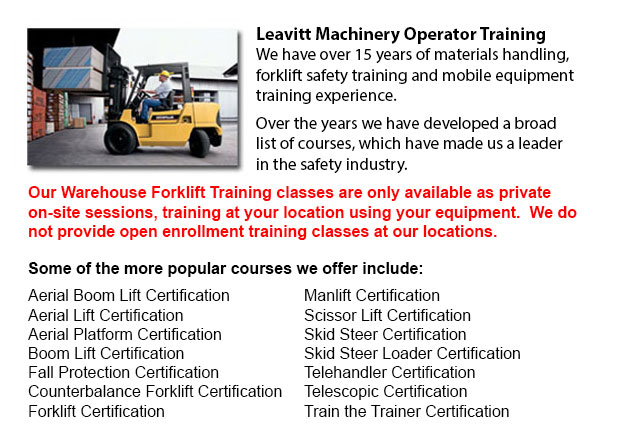
Toronto Warehouse Forklift Safety Training - Businesses often face liability for injuries and damage sustained in workplace accidents. Warehouses could be dangerous places to the people who work there. That is why employee safety is a top priority for lots of businesses. Warehouse safety training is among the most effective ways to protect workers, while minimizing expenses connected with injuries and accidents.
The warehouse holds large amounts of stock and materials that may pose dangers, particularly when these are being moved. The transporting of stock utilizing a powered machinery or manually could cause injuries the workers' hands, fingers, feet and toes. Tripping, falling and slipping are common reasons for injury. Heavy objects can fall off shelves and harm personnel. Forklifts and other machines carry inherent hazards as they manipulate heavily laden pallets. Wrong lifting is a common source of back injuries. Even nails, splinters and box cutters can lead to harm.
Warehouse conditions could change from one moment to the next, depending on the materials or substances being handling, the work being carried out and the machine being used. Due to the various possible hazards in warehouse environment, warehouse operations are regulated by many various standards. There are regulations for storage and material handling, for walking and working surfaces, and regulations governing the selection and use of PPE (personal protective equipment).
Most of the safety rules covered by a company will consist of common sense regulations. Regulations that warehouse personnel must be quite familiar with comprise:
1. While working in a warehouse, safety is a priority at all times.
2. When work calls for correct PPE, such as gloves, safety shoes, hard hats and eye protection, they must be worn.
3. Possible hazards should be checked and reported.
4. Understand warning signals and signs - and obey them.
5. Watch where you're going and concentrate on what you're doing.
6. Pay attention to what others are performing nearby - especially forklifts and various dangerous equipment.
7. Make certain that stacked products and materials are secured and stable.
Following good housekeeping rules will help to ensure a safe warehouse for all employees. Essential housekeeping regulations involve keeping floors and aisles clear of items, like for example wires and cords. Never perch objects insecurely on a surface. When spills take place, clean up right away. Throw garbage in correct containers. Keep fire exits, fire extinguishers and sprinklers accessible. Put box cutters and other sharp tools away immediately after use. Report tripping hazards like for example damaged or loose flooring.
-
Toronto Wheel Loader Training
Toronto Wheel Loader Training - Normally, the different kinds of heavy equipment training are classed into 2 categories of machinery: those that have rubber tires and tracked vehicles. Tracked vehicles consist of items like for example excavators, cr... More -
Toronto Heavy Equipment Operator Training
Toronto Heavy Equipment Operator Training - Heavy equipment operator training facilities that provide good standards in the business, providing field performance tasks and added machinery training are really sought after training features. Students a... More -
Toronto Manlift Operator Certification
Toronto Manlift Operator Certification - We provide an aerial lift and scissor platform certification and training to empower the trainee with the general understanding and knowledge of the safe and efficient use of "Power Operated Mobile Work Platfo... More -
Toronto Aerial Boom Lift Ticket
Toronto Aerial Boom Lift Ticket - Aerial lifts can be utilized to accomplish a lot of unique duties done in hard to reach aerial spaces. Some of the odd jobs associated with this type of jack include performing regular preservation on structures with... More -
Toronto Heavy Equipment License
Toronto Heavy Equipment License - Obtaining a heavy equipment license is mandatory in order to operate these big industrial machinery. Certification could be acquired through a vocational school or private training. The license would enable the drive... More -
Skid Steer Loader Training in Toronto
A skid-steer loader is an engine powered equipment which consists of a small and rigid frame. It is outfitted together with lift arms that are utilized to connect to a large variety of labor saving tools and attachments. Typically, skid-steer loaders... More -
Toronto Aerial Lift Certification
Toronto Aerial Lift Certification - Aerial Lift Certification is for individuals who requires an in-depth understanding of aerial lift safety. Inspectors and operators, supervisors, maintenance workers and construction craftsmen should perform a cert... More -
Toronto Boom Lift Training
Toronto Boom Lift Training - Elevated work platforms, also called aerial platforms, allow workers to carry out tasks at heights which would otherwise be not reachable. There are different kinds of lifts intended for various site conditions and applic... More

Forklift Certification Toronto
TOLL FREE: 1-888-254-6157
Toronto, Ontario
forkliftcertificationtoronto.com
Email Us
About Us


